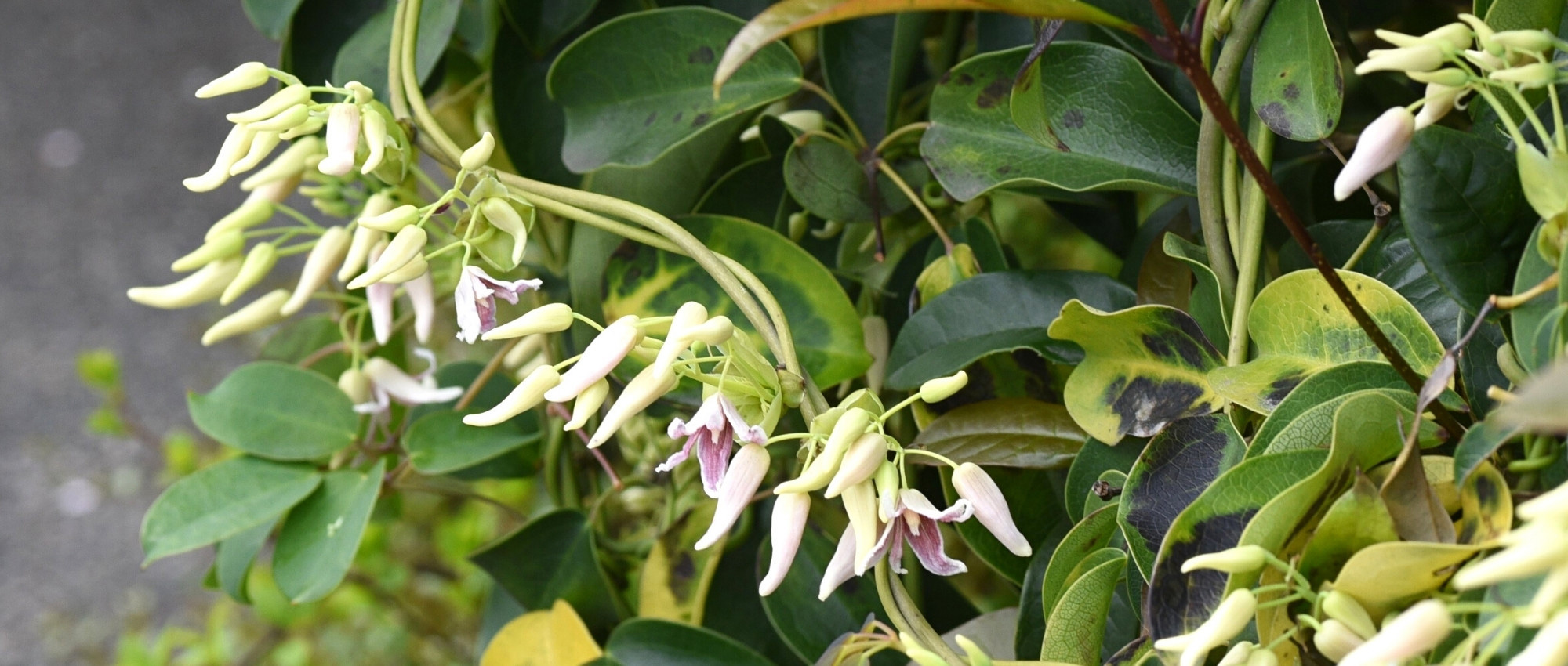
Stauntonia: 6 successful pairing ideas
For all garden styles
Contents
Stauntonia is a beautiful climbing plant that produces small bell-shaped flowers in spring, highly fragrant, in shades of pinkish white, cream yellow, or purple. It also features generous foliage, composed of evergreen, palmate leaves. In the garden, Stauntonia thrives in partial shade, in humus-bearing, cool, and well-draining soil, preferably acidic. It is a vigorous plant that grows quickly and requires little attention once established. It can even be grown in a pot and placed on a terrace or balcony, provided it has a support to climb on.
Discover in this guide our best ideas and inspirations for pairing Stauntonia with other perennials and bushes to easily create harmonious flower beds, whatever your garden style!
In a woodland garden
Stauntonia is a climbing plant native to the forests of East Asia, and it will easily find its place in a woodland garden, where its lush foliage will bring a very natural style. You can let it climb on a tree, for example alongside variegated ivies and small shade-loving perennials. Consider the decorative foliage of hostas, hakonechloa, and ferns. Play with colours using the foliage of heucheras, which come in a wide variety of shades! Also discover the stunning Fatshedera lizei ‘Variegata’, a hybrid between ivy and Fatsia, which offers variegated foliage! As for flowering, the small bells of Stauntonia will pair beautifully with the delicate blooms of Solomon’s Seal, Brunnera, Epimediums, sweet woodruff, lungworts, wild garlic, and comfrey. Also consider the small yellow flowers of the common primrose, Primula veris, ideal for adding little touches of brightness. These plants will together create a harmonious scene worthy of a true natural forest, yet a bit more floral.
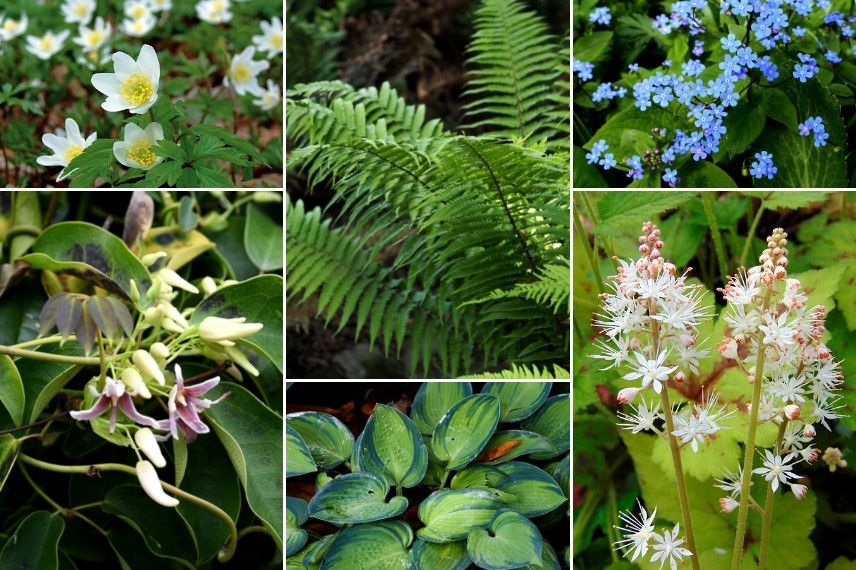
Stauntonia integrates easily into a woodland garden, with a very natural style. Anemone nemorosa (photo Pandano), Dryopteris wallichiana, Brunnera macrophylla, Stauntonia hexaphylla (photo Adobe Stock), Hosta ‘June’, Tiarella ‘Running Tiger’
With acidic soil bushes
As Stauntonia thrives in acidic soil and partial shade, it is perfect for accompanying heather soil shrubs. Pair it, for example, with Japanese Andromeda, Pieris japonica, which bears young red leaves in spring that later turn green, along with white or pink bell-shaped flowers. Also enjoy the generous flowering of azaleas and rhododendrons, as well as that of Skimmia. Discover the Fothergilla gardenii, a very original small bush that offers beautiful feathery white spike flowers. Also consider the Crinodendron hookerianum, which bears flowers resembling small red lanterns, as well as Michelia yunnanensis with its beautiful cup-shaped white flowers. Most of these shrubs offer white or pink flowering, ensuring a harmonious and delicate display. Finally, Leucothoe also deserves its place alongside them with its beautiful foliage that changes colour throughout the seasons.
To successfully cultivate them, feel free to consult our advice sheet “Planting heather soil shrubs”, as well as Michael’s article on our blog: “5 tips to successfully grow heather soil shrubs”
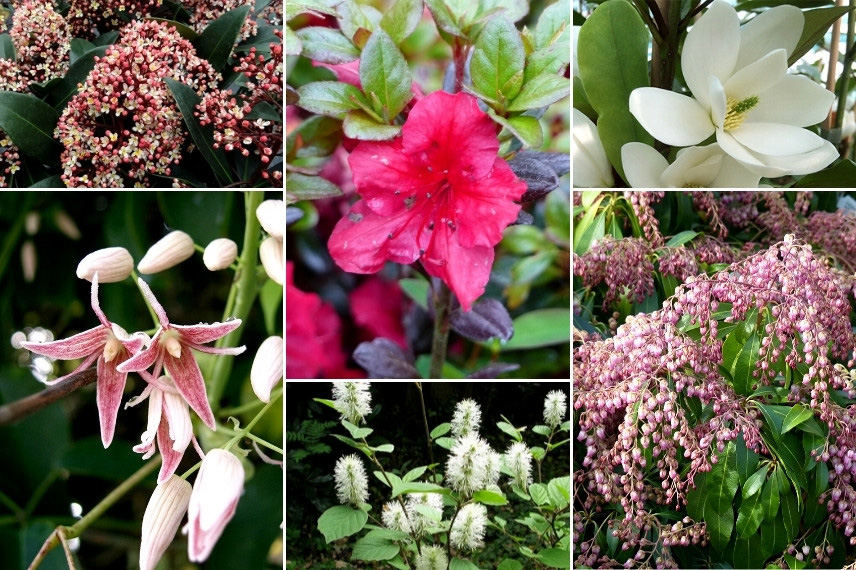
Feel free to pair Stauntonia with heather soil shrubs. Skimmia japonica ‘Rubella’, Japanese Azalea ‘Johanna’, Magnolia ‘Fairy White’, Stauntonia hexaphylla (photo KENPEI), Fothergilla major (photo peganum), Pieris ‘Katsura’
Discover other Stauntonia
View all →Available in 1 sizes
Available in 1 sizes
In a zen garden
Originating from Japan and Korea, Stauntonia, with its humble bell-shaped flowers and generous foliage, will easily fit into a zen garden, alongside other Asian plants. Create a small, calming, understated garden, for example in a patio or courtyard. Incorporate Japanese maples for their elegant silhouette and colourful palmate foliage, as well as Hakonechloa macra, hostas, and Nandina domestica. Consider the graphic foliage of ferns: we recommend, for example, Cyrtomium falcatum or Coniogramme emeiensis. Define the garden with a bamboo barrier: whether it’s tall bamboos like Phyllostachys nigra, with its stunning black canes, or dwarf bamboos like Pleioblastus pygmaeus ‘Distichus’, which reaches no more than 60 cm in height. Here too, azaleas, rhododendrons, Pieris japonica, and camellias will find their place alongside Stauntonia. Also discover the beautiful Japanese primroses, such as Primula japonica ‘Alba’. Don’t forget to incorporate a few decorative elements (sparingly): for example, an archway, lanterns, or a statue… You will create a garden conducive to meditation and ideal for recharging your batteries!
Explore our articles “Creating a Japanese or Zen Garden” and “Japanese Garden: 10 Iconic Perennial Plants”
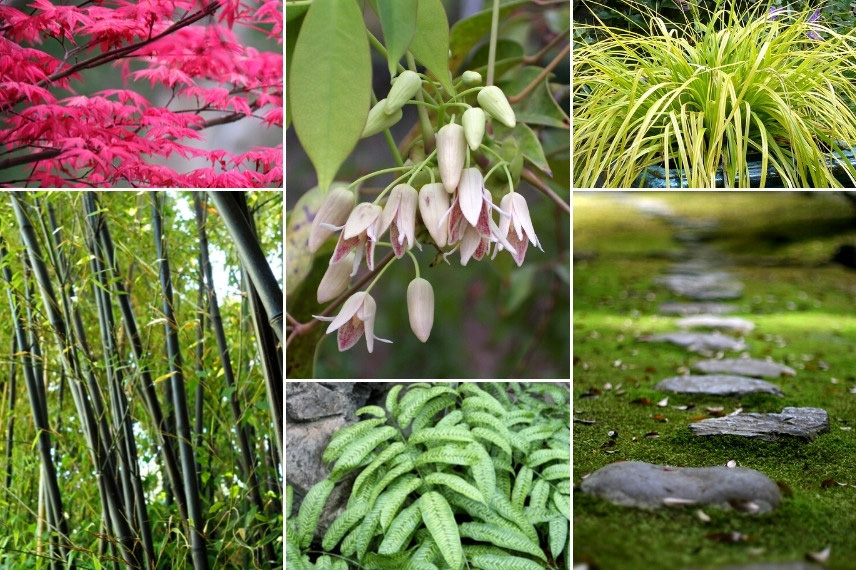
Create a zen garden with Stauntonia! Acer palmatum ‘Shindeshôjô’, Stauntonia hexaphylla (photo A. Barra), Carex oshimensis ‘Everillo’, Phyllostachys nigra, Coniogramme emeiensis
With spring-flowering bulbs and perennials
You can grow Stauntonia on a pergola, on a tree, or against the wall of your house, and create a stunning bed at its feet with small spring bulbs and perennials with colourful flowering. The small bells of Stauntonia will beautifully complement the elegant flowering of bluebells, daffodils, tulips, Puschkinia scilloides, camassia, and Ipheion uniflorum. Also consider the euphorbia amygdaloides, Lamium maculatum, pulmonarias, and bergenias. We also invite you to discover the lovely carmine-pink to violet flowering of Dodecatheon meadia, or Virginia shooting star. Not to mention the spring-flowering shrubs, such as spiraea arguta, Exochorda, and Viburnum burkwoodii, which can provide a beautiful bright backdrop for your bed. This combination will be perfect to celebrate the return of fine days in the garden while enjoying a bed full of colour!
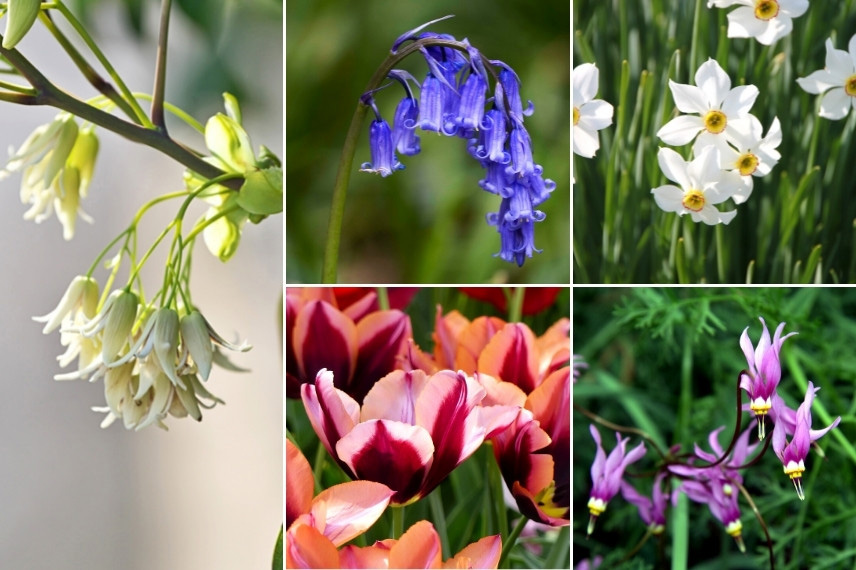
Accompany the flowering of Stauntonia with spring-flowering bulbs and perennials. Stauntonia hexaphylla, Hyacinthoides non-scripta (photo Michael Maggs), Narcissus poeticus ‘Recurvus’, Tulip ‘Muvota’, and Dodecatheon conjugens (photo C. T. Johansson)
In a jungle garden, with lush foliage
Stauntonia offers generous foliage with palmate leaves that somewhat resemble those of the Schefflera. Take advantage of this beautiful, uncommon liana to create a jungle garden with an exotic style, pairing it with other plants featuring lush foliage. Consider, for example, the Tetrapanax, Fatsia japonica, Astilboides tabularis, Gunnera, and giant hostas (for example, ‘Empress Wu’). The idea is to create a true sense of plant opulence, with foliage overflowing from the beds and intertwining with one another. Discover the beautiful dissected foliage of the Datisca cannabina, a monumental perennial that can reach 2.5 m in height! Think of akebias, a climbing plant quite similar to Stauntonia, which also produces beautiful palmate leaves made up of light green, ovate leaflets. Don’t forget ferns, the banana plant Musa basjoo, Melianthus major, bamboos, and palms (for example, Trachycarpus fortunei). Also, discover the surprising flowering of Arisaema griffithii, which resembles the head of a cobra. As for trees and bushes, consider the Catalpa, Albizia, and Paulownia tomentosa.
Check out our selection of XXL foliage perennials as well as Ingrid’s article on our blog: “10 exotic and hardy plants for jungle gardens”
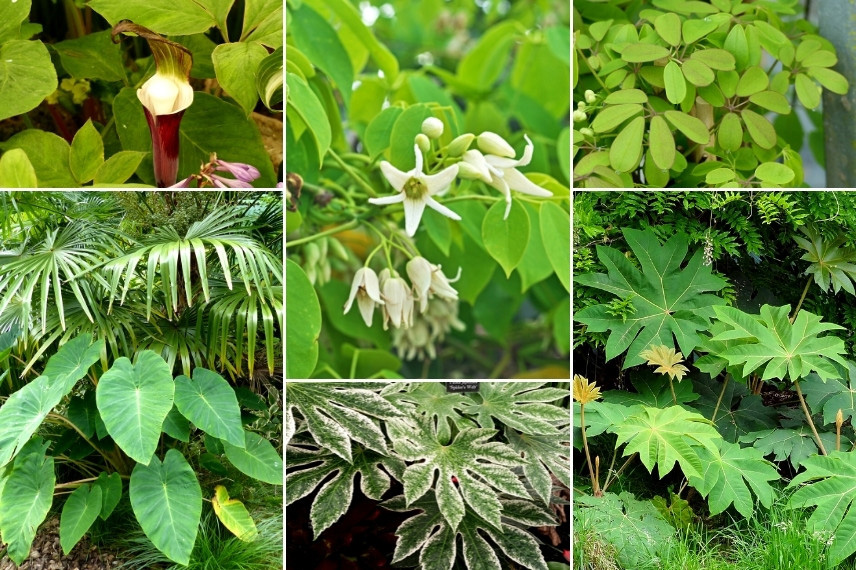
Stauntonia also integrates very well into a jungle garden, with exuberant foliage! Arisaema sikokianum, Stauntonia hexaphylla, Akebia quinata, Colocasia esculenta, and Trachycarpus fortunei, Fatsia japonica ‘Spider’s Web’, Tetrapanax papyrifera ‘Rex’
With other fragrant flowerings
Stauntonia delights us in spring with its small, highly fragrant flowers. Take the opportunity to create a scented garden by surrounding it with bushes that stand out for their pleasantly fragrant flowering. For example, you can plant alongside it a Choisya ternata, whose white flowers in spring release an orange blossom scent, the Camellia ‘Cinnamon Scentsation’, with its spicy and sweet fragrance, and the Osmanthus burkwoodii, whose flowers exude a jasmine scent. Also consider the golden currant Ribes odoratum, as well as Daphne ‘Perfume Princess’.
For more options, discover our selection of fragrant bushes!
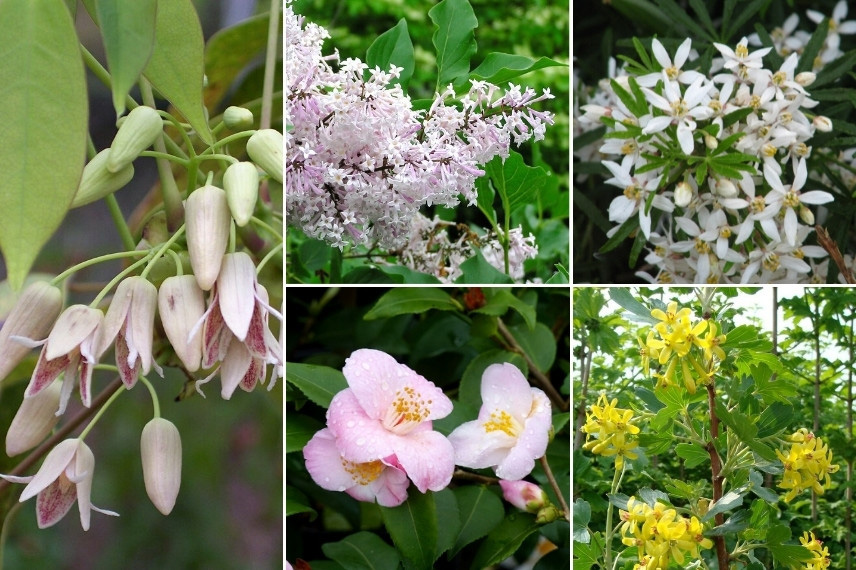
Create a scented garden with Stauntonia and bushes with pleasantly fragrant flowering! Stauntonia hexaphylla (photo A. Barra), Syringa ‘Miss Kim’ (photo normanack), Choisya ternata ‘White Dazzler’ (photo Peganum), Camellia ‘Cinnamon Scentsation’, Ribes odoratum (photo Denolf)
- Subscribe!
- Contents


































Comments